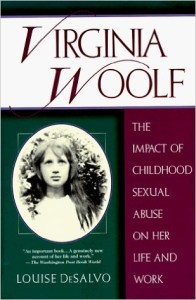I was convinced by this biographical and literary study, of three things. One, Virginia Woolf was sexually abused by her half-brother, George Duckworth, and two, that her alleged madness was a depressed and confused reaction to that childhood trauma (along with medications and social isolation). Her suicide was an understandable consequence of the trauma. And three, I became convinced that much of Woolf’s fiction was driven by her attempts to come to terms with her trauma, in the absence of any one to help her, since such matters could not be discussed.
I was also convinced by the description of her childhood household, a patriarchal Victorian house of horrors that severely oppressed girls, deprived them of education and tolerated their sexual abuse, but that was not new information. That kind of sociocultural analysis is widely available.
Scholars and readers who object to DeSalvo’s conclusions (and methods, and thesis) generally argue that the evidence is not clear and that the argument is speculative. This gets down to what counts as evidence. Facts are, by definition, propositions that are generally accepted in a consensus community as true. They need no defense because they have already been agreed to. For example, if Woolf had written in her diary that she had been sexually abused by George Duckworth, then that would be a fact.
Actually, she did write that, so DeSalvo’s fundamental thesis is fact-based. Details, we do not have written in Woolf’s hand: how badly was she abused, in what exact ways, how many times, how roughly; what did they talk about, and so on. Details, details. We don’t have them.
DeSalvo draws forth many of those details by implication from Woolf’s diaries, letters, and fiction, and concludes that George and brother Gerald repeatedly abused both Virginia and her sister Vanessa. Critics object to such inferences, saying they are not factual. I found them completely reasonable and compelling.
Except to the most extreme positivist, facts do not have to be declarations written out in longhand. Since the time of John Locke it has been accepted that facts can be inferred by reason from observational data, and I found DeSalvo’s reasoning to be conservative and convincing. For example, she compares accounts of contemporary female sexual abuse survivors to passages in Woolf’s diaries and fiction and shows startling similarities. In my way of thinking, that counts as evidence.
Having worked with sexually abused children for over a decade, everything I read in DeSalvo’s thesis was consistent with my experience. Also the pictures were valuable, especially the one of Virginia standing next to George Duckworth – it is creepy in a spine-shuddering way for anyone who knows how to “read” pictures.
The one area where my skeptical hackles went up was when DeSalvo indulged in psychoanalytic interpretations of certain passages from Woolf. That really is flimsy speculation. However, even there, it is a fact that Woolf read Freud (as part of her quest for self-healing, DeSalvo says), so a psychoanalytic commentary is not totally inappropriate.
A peeve I cannot resist mentioning is that there is no consideration of Woolf’s novel, Orlando, which I was particularly interested in, and which does appear in the index, but is utterly missing from the text. That would be some editor’s error. Other Woolf novels are analyzed in considerable detail to support the author’s thesis.
Overall, this book gave me plenty of fresh insight into Virginia Woolf and her works and I found it valuable, well-written, accessible, and completely believable.
DeSalvo, Louise, (1989). Virginia Woolf: The Impact of Childhood Sexual Abuse on her Life and Work. New York: Ballantine, 375 pp.

